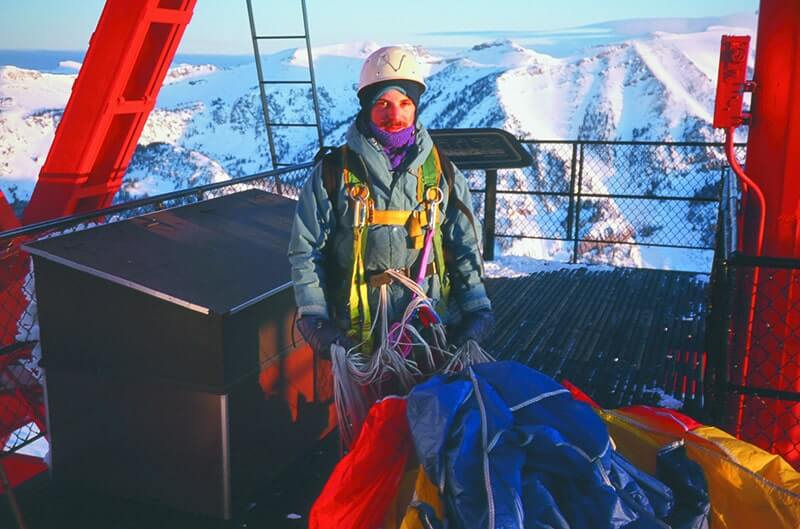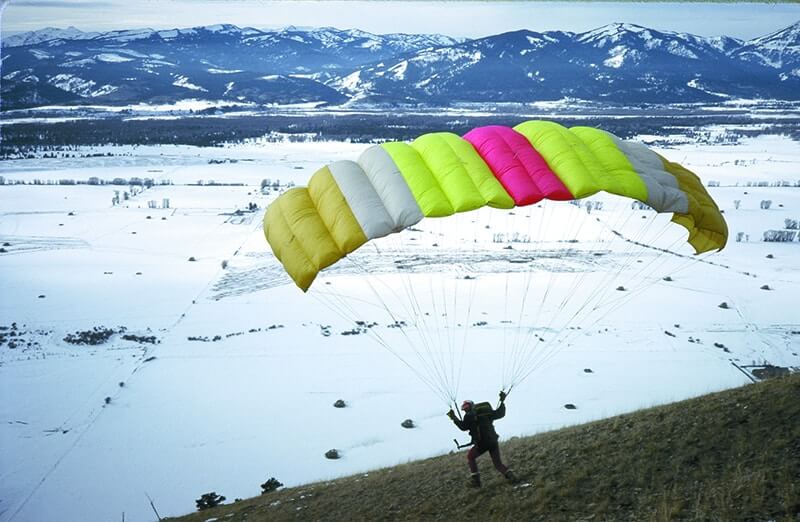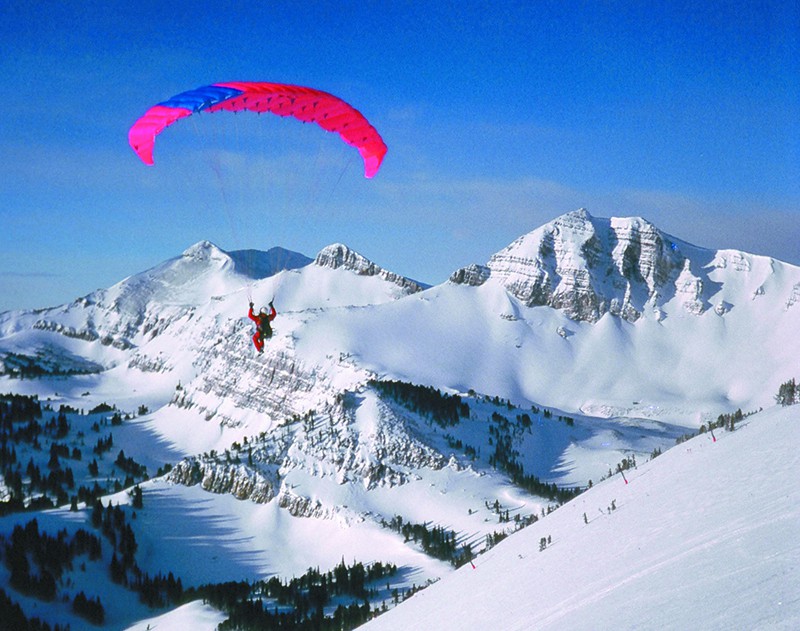Read The
Current Issue
Birds Eye View
Thirty years ago, paragliding was a new sport in the valley; today Jackson Hole is a paragliding destination.
By Leslie Hittmeier

Kurt Kleiner launches a British “Harley” paraglider off Rendezvous Bowl in 1990. Photo by John Carr/Courtesy Photo
ON A DEAD calm morning in December of 1987, 28-year-old Aerial Tram operator and wildland firefighter Kurt Kleiner became the first person to paraglide off Rendezvous Mountain at Jackson Hole Mountain Resort (JHMR). Because he was an employee at the mountain and had good rapport with his supervisors, it just took a conversation about how he would be safe and manage risk to get the green light. There was no crowd or news team waiting at the bottom, just a few curious ski patrol friends. To Kleiner, who had done at least fifty flights around the valley by this time, this was just another day.
Kleiner wasn’t only the first person to soar off Rendezvous’ 10,450-foot summit. He was also the valley’s first paraglider. An avid skydiver, Kleiner had arrived in Jackson (from Missoula, Montana) the prior spring with a newly purchased paragliding canopy. (Paragliding canopies, or wings, only became commercially available in the mid-1980s.) Kleiner began playing with his new toy shortly after arriving in Jackson. “As soon as I started to explore [here], I saw the potential for paragliding was unlimited—there were so many places to fly,” Kleiner says. “It was a perfect environment because of the open grassy hills and the predictable wind and weather conditions. There was immense opportunity to establish the sport and grow it in Jackson.” It didn’t take long for others to become interested in the new sport. “Right away there were people who wanted lessons,” Kleiner says.
“As soon as I started to explore [here], I saw the potential for paragliding was unlimited—there were so many places to fly,” Kleiner says.
Today there are more than 130 paragliders who live in Jackson Hole. And the valley is a destination for paragliders from around the world. Commercial tandem paragliding has been an adventure the public could have—like whitewater rafting or horseback riding—since the mid-1990s. Back then, Ken Hudonjorgensen took thrill-seekers for flights under his canopy from the top of the JHMR tram, and Jon Hunt and Tom Bartlett, Kleiner’s first two students, founded Peak Paragliding, which did tandem flights from the top of the main lift at Grand Targhee Resort on the western side of the Tetons. In 1999, Bartlett and Scott Harris started Jackson Hole Paragliding, which has been in operation since and offers everything from scenic tandem flights to ongoing lessons and training that result in pilots earning advanced instructor ratings.
HUNT AND BARTLETT were ski buddies with Kleiner, and he began “teaching” them how to paraglide in spring 1988. Teaching is in quotes because today there is an official national training protocol that results in students attaining a paragliding license through the United States Hang Gliding and Paragliding Association, but Kleiner says that back then there weren’t any training standards. Neither was there tandem paragliding, in which a student sits in a harness attached to an experienced pilot. “So I was winging it a little bit,” Kleiner says. “I was conservative and had people run on shallow terrain and do really short glides 10 feet off the ground to start.”
After a few lessons, Hunt and Bartlett bought their own gear, and suddenly the number of paragliders in Jackson tripled. “Back then it was short flights in skydiving harnesses. We were flying off the side of Game Creek Canyon and landing on the road,” says Bartlett, who’s now 54. This style of flight, where a pilot takes off and glides to the ground within ten or fifteen minutes is called a “sled ride.”
Between 1988 and 1990, the group discovered and launched from many of today’s most popular paragliding sites, like Curtis Canyon, Snow King Mountain, Beaver Mountain, Mount Glory, and the butte across the highway from Astoria Hot Springs. The men learned more and more with every flight. “Sometimes you’d feel pretty alone up on the hill trying to figure things out,” Bartlett says.
The first time Kleiner launched off Mount Glory, which was the first time anyone had launched off Mount Glory, the wind was light. He predicted an easy sled ride down to his car. But instead of going down, he went up. And up, and up. “I noticed that the clouds above were rapidly maturing into thunderheads,” he says. Kleiner was getting sucked up into a cumulonimbus cloud. “The only way I was able to come down was to put my canopy into a stall.” He plummeted toward the road. “About 200 feet above the ground I let the canopy back out,” he says. As Kleiner packed up his canopy and harness it began to hail.
Sled rides were exhilarating, but the men had dreams of flying for longer distances and times. (This type of flying is called “cross country,” in contrast to the short-in-time-and-distance sled rides.) The limiting factor was the equipment, specifically harnesses, which were uncomfortable to sit in for long periods of time. (Early paragliding harnesses were skydiving harnesses.) In 1989, a paragliding-specific harness was invented and pilots could extend their flying times. Kleiner, Hunt, and Bartlett, along with newbie pilots Luke Madsen and John Patterson, started to get more and more into cross-country flying.
In 1992, Patterson took about two hours to fly across the valley, from Wilson to Jackson. The next year, Hunt was the first person to fly to and over the Grand Teton from Teton Village. In 1994, Patterson flew from Teton Village to Pinedale. Every year, the flights got longer in time and distance. Last summer, local pilot John Hovey flew from the JHMR gondola to Lander, Wyoming—170 miles from Teton Village by road—in about three hours, and Trey Hackney flew to Pocatello, Idaho, 140 miles away by road, in two and a half hours. The longest flight originating in Jackson Hole was done by Nick Greece and Hunt, who in 2016 flew from Wilson to Rawlins, Wyoming—a distance of more than 200 miles. It took them about eight hours.
“Paragliding is a very niche sport in the U.S., so to find a large active community in such a beautiful setting is amazing,” says Paraglider
Becca bredehoft
KLEINER MOVED AWAY from Jackson in 1991—“it feels special to have been the first [paraglider],” he says—but the sport continued to grow. The Jackson Hole Free Flight Club formed in 1992 with about a dozen members. Its mission statement is: “To secure present and future flying sites and self-regulate one another to ensure the future growth and safety of the sport.” Today the club has about ninety members, which makes it one of the largest paragliding clubs per capita in the country.
People now move to Jackson Hole for the paragliding community and opportunities. Becca Bredehoft, a 34-year-old who has been flying paragliders since she was 14 and now works seven days a week in the summer doing tandem rides and instructing for Jackson Hole Paragliding, did that 15 years ago. “Paragliding is a very niche sport in the U.S., so to find a large active community in such a beautiful setting is amazing,” she says. Her first summer in the valley she did one of the valley’s most iconic flights: from the top of the JHMR tram north to the Grand Teton and then back. (Paragliders are not permitted to launch or land in Grand Teton National Park, but flying over it is perfectly acceptable.) Bredehoft launched from the top of the tram, which is about 12 miles south of the Grand as the crow (or paraglider) flies, around noon. She caught thermals and, as she began heading north, climbed up to about 15,000 feet. (The Grand Teton’s summit is 13,770 feet.) “I waved to climbers on top of the Grand and was back to Teton Village by late afternoon in time to make it to my evening waitressing job,” she says. “I was ecstatic. I did it two more times that week.”
The Tetons aren’t just an epic place to paraglide because of the views, but also because of conditions. Jackson Hole usually gets wind from the west—it comes in smooth across Teton Valley, Idaho’s expansive flats and then hits the Tetons, which are a formidable windblock. The mountains’ mass causes significant turbulence. This turbulence makes for exciting flying, but it also makes paragliding here more challenging than in other popular American paragliding destinations like Santa Barbara, California; Sun Valley, Idaho; and Aspen, Colorado. “If you can fly in the biggest, toughest, most rowdy conditions in Jackson, you can fly anywhere,” says Blake Votilla, a 27-year-old pilot and tandem instructor-in-training with Jackson Hole Paragliding.
“Paragliding feels like a combination of a chairlift, a magic carpet, and a roller coaster,” Bredehoft says. “Flying under the sheer forces of physics, while being intimately connected to the environment is hard to beat—feeling the subtle changes of the air around you, the silence of the space, the wind on your bare skin. There is no other way to get this experience.” Tandem rides with certified pilots start at $295, 307/739-2626, jacksonhole.com/summer-paragliding.html JH

Kleiner atop the tram dock on a sub-zero morning in the late 1980s. “I decided to open up the wing and get it ready and clip in my carabiners while inside the tram car during the ride up since only two or three other people were in that car,” Kleiner said. “I just wanted to minimize any time needed to stand around outside before launching.” Courtesy Photo

Luke Madsen launching from East Gros Ventre Butte in 1990. “Luke was already a trained pilot with some experience when he arrived on the scene, and it was great to have other pilots arriving in the valley,” Kleiner says. Photo by Kurt Kleiner / Courtesy Photo

Kleiner flying a new Performance Designs 33-cell Excalibur at Curtis Canyon in August 1990. Photo by Bill Willcox / Jackson Hole news file





